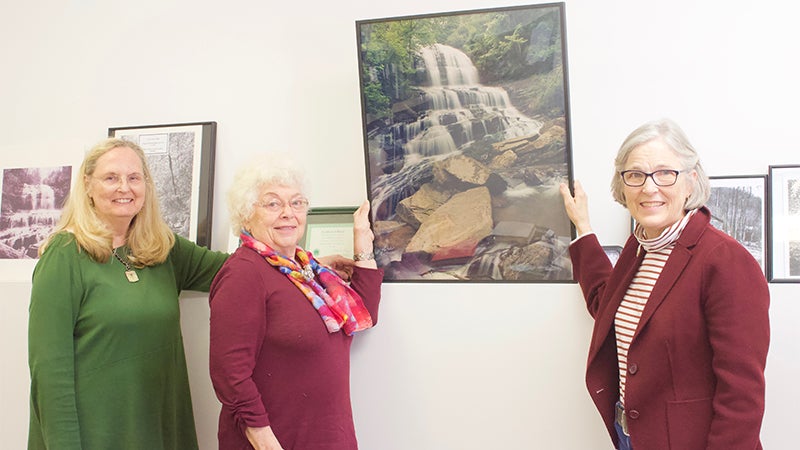Ninety years of protecting natural beauty
Published 10:07 am Monday, April 16, 2018

- Members of the Tryon Garden Club display a photo of Pearson’s Falls inside their archives Tuesday afternoon. Pictured are, from left, Joy Soderquist, club historian and archivist; Donna Southworth, president; and Lucy Brannon, publicity (Photo by Ted Yoakum/Tryon Daily Bulletin)
Garden Club continuing legacy of service
TRYON — Even nestled amongst an area lush with great, rolling mountains; vividly colored, fragrant wildflowers; and giant, luscious trees, Saluda’s Pearson’s Falls never fails to capture the imagination of those who witness it.
Surrounded by flora that still remains largely undisturbed by humans, the 90-foot tall waterfall remains a symbol of the natural beauty that draws so many to the Foothills region.
For more than 85 years, the preservation of the gem has fallen on the shoulders of a group of people, whose passion for protecting and beautifying Tryon and the surrounding area has remained steadfast for generations.
The Tryon Garden Club is celebrating its 90th anniversary this year. The organization kicked off its commemoration of the milestone earlier this month with a special reception ceremony at the Lanier Library, where members and guests enjoyed a giant birthday cake, checked out some historic club minutes and other artifacts from the club’s archives, and listened to a presentation from local historian Mike McCue about famed naturalist Donald Culross Peattie, whose letter to the garden club in 1931 helped convince its members to purchase the Pearson’s Falls property.
The Tryon Garden Club “sprouted” from Tryon’s Lanier Club (the predecessor of the town’s Lanier Library). Members of the Lanier Club were interested in gardening and natural preservation since the group was in the early 1900s, with a small group coming together at the club or in private homes to share any tips or problems they were having with their gardens.
In 1928, the Tryon Garden Club officially blossomed to life, with Minnie Hester elected as the group’s first president. Some early projects the club embarked on included sponsoring garden tours, planting trees at Harmon Field and other local properties, and awarding prizes to local gardeners for their efforts to spruce up their fields and yards.
Three years later, the club embarked on the mission that continues to define it to this day — acquiring Pearson’s Falls.
In 1931, Donald Culross Peattie, son of one of the club’s officers, Elia Peattie, wrote a letter imploring the garden club to find a way to protect the waterfall and surrounding glen, which were in danger of being acquired by a timber company in 1931, said Joy Soderquist, the historian and archivist with club. Peattie, who was living abroad at the time, had a deep love for the natural beauty of the Foothills area, with he and his brothers growing up exploring the falls, Tryon Peak and other such destinations in the area.
In response to Peattie’s request, the club formed a conservation committee, chaired by Hester, to explore how the organization could save the falls. As the area leading to the falls did not have a road at the time, Hester and other members of the club “hiked up their skirts” and made their way through woods to explore the property, crossing over Colt Creek by foot, as there was no bridge to the falls at the time, Soderquist said.
With the help of a loan from member Frances Lightner and her husband, C.A., the club officially purchased the approximately 425-acre property on Nov. 6, 1931. The club itself had raised $550 for the purchase, Soderquist said.
“They raided their lingerie drawers in order to find extra money for the purchase,” she said. “They did not want to lose that property.”
Shortly after purchasing Pearson’s Falls, the club opened the property to the public, charging 25 cents for admission. Prior to the building of the caretaker’s house and ticket booth at the falls, visitors had to rent at key to enter the property from either Owen’s Pharmacy or Missildines — though many people forgot to turn in their keys after their visit, Soderquist said.
To help pay for improvements and maintenance costs for the property, the members hosting flower shows and teas — they also brought in a guest speaker once, but quickly abandoned the idea after people told them the Lanier Library were also organizing lectures but without charging people to attend them, Soderquist said. The club also began selling postcards featuring a wood carved etch of the fall created by artist Clare Leighton, in packs of three for 5 cents, Soderquist said.
Under the stewardship of the club, many improvements were made to the falls and glen, including the construction of a caretaker’s home on the property in the 1950s.
Today, Pearson’s Falls are more popular than ever, members said. Last years, 26,301 visited the falls, which hosts field trips for local students.
In addition to caring for Pearson’s Falls, the Tryon Garden Club also tends to the garden outside the historic Tryon train depot, and regularly hosts lectures from experts in gardening and the outdoors, to promote horticulture in the area. There are currently 64 members in the organization — the two most recent recruits signed up following this month’s 90th anniversary celebration.
To find out more about the club and its efforts to preserve Pearson’s Falls and enhance the beauty of the area, visit https://www.pearsonsfalls.org or call (828) 749-3031.





